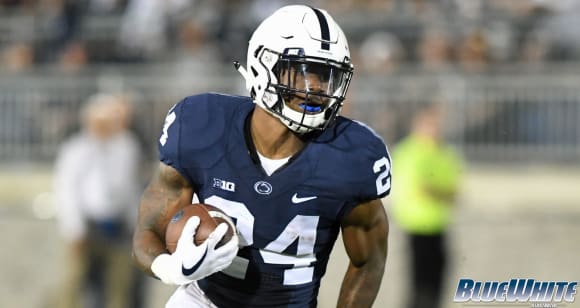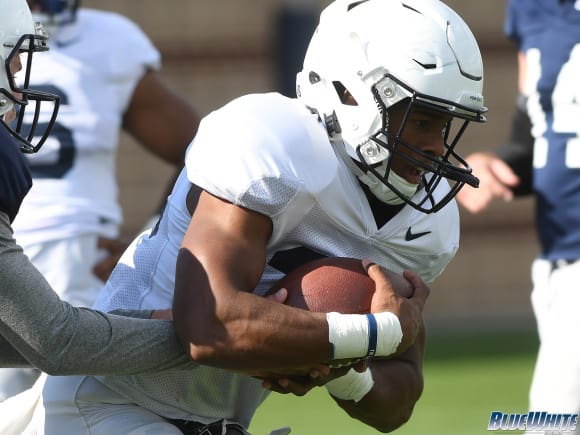Life behind Barkley not always easy
Penn State has a trio of running backs who would likely start at a majority of college football programs across the country. None of them are named Saquon Barkley.

Behind the Heisman contender on the Nittany Lions’ depth chart are junior Mark Allen and sophomores Andre Robinson and Miles Sanders. They, head coach James Franklin says, “are in a challenging, tough situation because they’re good enough to start for us and win for us, but we have one of the better football players on the planet” ahead of them.
It’s not always easy to oblige, standing on the sideline watching one of the sport’s most explosive athletes operating in one of its most intriguing offenses. Each day, though, they've come back to work to not only advance their own skill set but to also adjust their mindset in order to best embrace the idea of being the guys who are behind Barkley.
Position coach Charles Huff sees firsthand their maturation in how they’ve settled into their unique roles over the course of their careers.
“I think they all understand now, which I’m not totally sure they all fully understood a year or two ago, that obviously they’re playing behind a really good football player,” he said. “It’s not that they are not good football players. They’ve got to be able to maximize their opportunities while also learning and preparing mentally for the moment when they become the starter or the guy in the game. I think they’re doing a better job of that this season.”
Speaking to reporters on a teleconference Thursday, Huff’s comments echoed those of Franklin’s from the night before. With three backups who the coaches consider to have first-string potential, there are only so many opportunities to touch the ball in an offense that’s centered around Barkley. He’s on the field for well over half of the snaps, whether he gets the ball or serves as decoy. The rest of the play are left to be divvied up.
Playing time is minimal and that makes each carry or reception all the more precious for when Allen, Robinson or Sanders are in the game. Why both Franklin and Huff both asked publicly for them to “maximize” each shot to affect the game in a positive way rather than the other way around is because that hasn’t necessarily been the case so far.
Huff points to Robinson’s near-TD reception against Akron as one missed opportunity. Robinson also was part of a dropped snap against Georgia State. Underscored was Sanders’ fumble against Pitt, Huff said, “that we were lucky enough to recover.”
There have been positives. Aside from the miscue against Pitt, Sanders has averaged 11.4 yards on five carries, including a 29-yard TD scamper against Georgia State. Robinson scored a TD last week, too, and he averages 9.0 YPC. Allen made his return after missing the first two games and he added 9 yards on two carries and appears to be ready to push his teammates and put an even higher premium on playing time among the running back unit.
“I don’t think the time that Mark had missed has set him back at all,” Huff said. “He’s in the same group as he was.”
Translation: Now there’s another option who deserves a split of of the carries that Barkley doesn’t get, upping the ante on an already limited number. It makes for a consistent competitiveness in Huff's room that without a doubt can be frustrating at times.
Beyond vying against a couple other worthy candidates, the fabric of the offensive system that Penn State runs also puts a ceiling on how many chances these guys get. A check-with-me type of scheme, like Joe Moorhead employs, determines how many times they get the ball in their hands. For the same reasons why Barkley is averaging only about 16 offensive touches per game are what make it difficult to ensure that his backups get an equal amount of chances.
If the defense is presenting a look that appears conducive to a run play, they’ll call it. If not, if a defense brings a safety closer to the line of scrimmage, they’ll call something other than a handoff. It’s not often when the RBs know when they're getting the ball.
While they wait, it’s up to them to maintain a positive outlook and then be ready to make do with what the they get.
“We talk in our room all the time, you can’t control what you can’t control,” Huff said. “You can’t control when you get in the game. You can’t control how many carries, how many plays or how many yards. You can go in a game for 10 plays and and the defense calls for 10 passes. That doesn’t mean you’re not a good running back. I think last year all three of those guys sometimes were allowing that to dictate whether they had a good game or not. Obviously you want to score and touch the ball, but that doesn’t mean you had a good game because you did touch the ball or didn’t touch the ball. I think this year all three of those guys understand that now.”
Freshman Journey Brown developing from track star to college football player

While Penn State’s depth chart at running back is top heavy, at the bottom is true freshman Journey Brown, toiling away on the scout team, making progress toward his development.
A redshirt from Meadville, Pa., Brown was a late addition to Penn State’s Class of 2017. He was also the fastest high school sprinter in Pennsylvania track and field and he compiled boatloads of yards as a running back, playing competition from a lesser-known part of the state. When he showed up on campus, compared to many of his classmates, there was still some work to do. Compared to some of his upperclassman teammates, especially, there was even more.
The progress that he has made since, however, is among the greatest of the newcomers. “I would say Journey has probably made the biggest strides,” Huff said.
With time, the 5-foot-11, 200-pounder is on the path to transform from a speedster to an all-around ball carrier.
“When he first got here he was a track guy who was really, really fast, who was athletic enough to be a good football player,” Huff said. “Now he’s put on weight. He’s still very fast. You can tell when he touches the ball he looks different. Now he is starting to understand our scheme, our concepts. He’s starting to understand college, the lifestyle of going to class, (that it) is more than lifting weights and going to meetings, all those things. So I’d probably say he has made the biggest strides. When he first got here, he was a track guy. He is fast but he had a ways to go with football. Now you’re starting to see things from a football perspective that make you say, OK, this guy has a chance to be really good.
“With that being said, he probably had the widest gap to close than some of the other guys. We knew he was a little raw when we recruited him just because he was multi-sport. He played basketball, he did track, he played football, so there was never really a time he just devoted to developing as a football player. He was constantly developing as an athlete. Now that he’s been here since (the summer) he’s starting to develop as a football player who has unbelievable athletic ability, so we’re really impressed and excited about where he’s going to be in a year.”